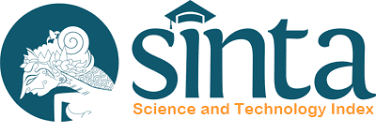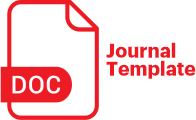SEIAR Epidemic Model on the Spread on the Spread of COVID-19 in the Special Region of Yogyakarta
DOI:
https://doi.org/10.26555/jim.v10i1.30866Keywords:
Model Epidemik,, COVID-19,, Titik Kesetimbangan,, Simulasi Numerik,Abstract
Severe Acute Respiratory Syndrome Coronavirus 2 ( SARS-Cov-2) merupakan virus varian baru yang menyebabkan penyakit menular yang disebut dengan Coronavirus Disease (COVID-19). World Health Organization (WHO) menyatakan COVID-19 sebagai pandemi global pada tanggal 11 Maret 2020. Untuk menggambarkan penyebaran COVID-19, pada artikel ini disusun model epidemik SEIAR yang menunjukkan dinamika populasi dari lima kompartmen, yaitu kelompok rentan, kelompok terpapar, kelompok terinfeksi bergejala, kelompok terinfeksi tanpa gejala, dan kelompok sembuh. Hasil penelitian ini diperoleh dua titik kesetimbangan, yaitu titik kesetimbangan penyakit dan titik kesetimbangan endemik. Analisis kestabilan titik kesetimbangan dengan menggunakan kriteria Routh-Hurwitz menunjukkan titik kesetimbangan bebas penyakit bersifat stabil asimtotik lokal pada saat R_0<1 dan tidak stabil pada saat R_0>1 . Selanjutnya, pada prediksi kasus COVID-19 di Daerah Istimewa Yogyakarta yang diperkirakan nilai R_0=1,48. Kemudian dilakukan analisis sensitivitas untuk mengetahui parameter yang paling berpengerauh terhadap bilangan reproduksi dasar. Hasil penelitian menunjukkan laju infeksi (β) merupakan parameter yang paling berpengaruh terhadap penyebaran COVID-19 di Daerah Istimewa Yogyakarta. Hasil penelitian ini diharapkan menjadi salah satu referensi kepada pemerintah Daerah Istimewa Yogyakarta untuk menekan laju infeksi pada kasus penyebaran COVID-19.
References
WHO, “Coronavirus disease (COVID-19),” WHO.
Kemenkes, “Kesiapsiagaan Menghadapi Infeksi Covid-19,” Kemenkes.
D. Aldila et al., “Chaos , Solitons and Fractals A mathematical study on the spread of COVID-19 considering social distancing and rapid assessment : The case of Jakarta , Indonesia,” Chaos, Solitons Fractals Interdiscip. J. Nonlinear Sci. Nonequilibrium Complex Phenom., vol. 139, p. 110042, 2020, doi: 10.1016/j.chaos.2020.110042.
I. Nurlaila, A. A. Hidayat, and B. Pardamean, “Lockdown strategy worth lives : The SEIRD modelling in COVID-19 outbreak in Indonesia Lockdown strategy worth lives : The SEIRD modelling in COVID-19 outbreak in Indonesia,” 2021, doi: 10.1088/1755-1315/729/1/012002.
M. Z. Ndii and Y. A. R. I. Adi, “Modelling the transmission dynamics of covid-19 under limited resources,” pp. 1–24, 2020,doi: 10.14421/fourier.2020.91.1-9.
A. R. Nuha and L. Yahya, “Analisis Dinamik Model Transmisi COVID-19 dengan Melibatkan Intervensi Karantina,” vol. 3, no. 1, pp. 66–79, 2021.
M. Abrori, “A Mathematical Model of the Covid-19 Cases in Indonesia ( Under and Without Lockdown Enforcement ),” vol. 9, no. 1, pp. 15–19, 2020, doi: 10.14421/biomedich.2020.91.15-19.
Y. A. Adi and M. Z. Ndii, “Modeling and Prediction of COVID-19 with a Large Scale Social Distancing,” vol. 9, no. 1, pp. 1–9, 2020, doi: 10.14421/fourier.2020.91.1-9.
S. Annas, M. I. Pratama, M. Rifandi, W. Sanusi, and S. Side, “Stability Analysis and Numerical Simulation of SEIR Model for pandemic COVID-19 spread in Indonesia,” Chaos, Solitons Fractals Interdiscip. J. Nonlinear Sci. Nonequilibrium Complex Phenom., p. 110072, 2020, doi: 10.1016/j.chaos.2020.110072.
N. Anggriani, M. Z. Ndii, R. Amelia, and W. Suryaningrat, “A mathematical COVID-19 model considering asymptomatic and symptomatic classes with waning immunity,” Alexandria Eng. J., vol. 61, no. 1, pp. 113–124, 2021, doi: 10.1016/j.aej.2021.04.104.
F. Adi-Kusumo, N. Susyanto, I. Endrayanto, and A. Meliala, “Model Berbasis Sir Dalam Prediksi Awal Penyebaran Covid-19 Di Daerah Istimewa Yogyakarta (Diy),” J. Mat. Thales, vol. 2, no. 1, pp. 1–10, 2020, doi: 10.22146/jmt.55820.
D. Kesehatan DIY, “Data Terkait COVID-19 di D.I. Yogyakarta,” Dinas Kesetahan DIY.
B. DIY, “Badan Pusat Statistik Daerah Istimewa Yogyakarta,” BPS Provinsi DIY.
Downloads
Published
Issue
Section
License
Copyright (c) 2025 sitirizkiayuni, Yudi Ari Adi

This work is licensed under a Creative Commons Attribution-NonCommercial-ShareAlike 4.0 International License.
Authors who publish with this journal agree to the following terms:
1. Authors retain copyright and grant the journal right of first publication with the work simultaneously licensed under a Creative Commons Attribution License that allows others to share the work with an acknowledgment of the work's authorship and initial publication in this journal.
2. Authors are able to enter into separate, additional contractual arrangements for the non-exclusive distribution of the journal's published version of the work (e.g., post it to an institutional repository or publish it in a book), with an acknowledgment of its initial publication in this journal.
3. Authors are permitted and encouraged to post their work online (e.g., in institutional repositories or on their website) prior to and during the submission process, as it can lead to productive exchanges, as well as earlier and greater citation of published work.

This work is licensed under a Creative Commons Attribution-ShareAlike 2.0 Generic License.









